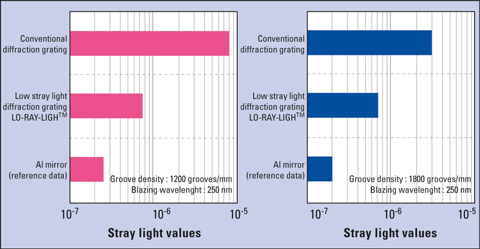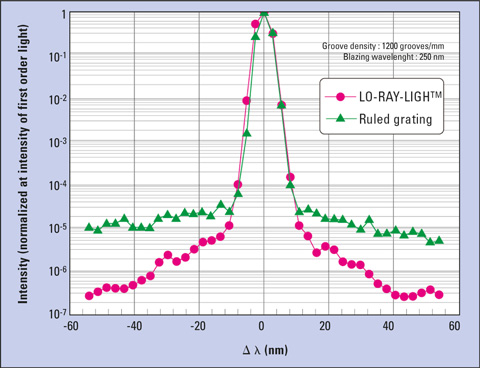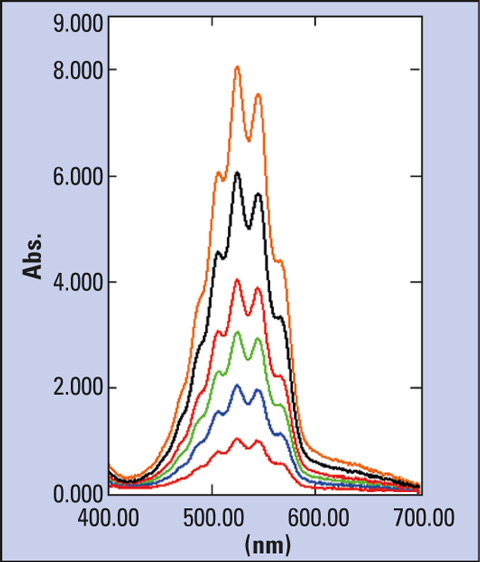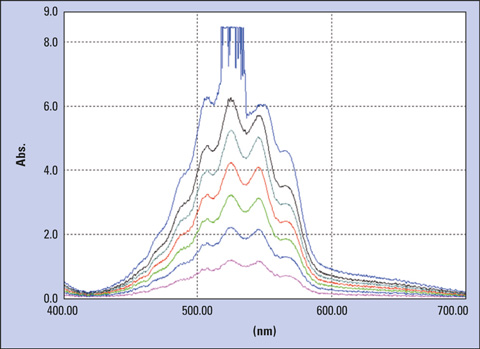Argus eyes
New class of UV-VIS double-beam spectrophotometers
Shimadzu’s role as worldwide market leader in UV-VIS double-beam spectrophotometers means continuous challenges for R&D to meet the high expectations of users from all over the world and to set standards in instrument development. Shimadzu designs not only complete analytical systems but also the optical components for a spectrophotometer. This article focuses on a patented development in diffraction grating technology.
New holographic exposure method
Shimadzu has optimized the quality of the edges for the angle of reflection in the sawtooth pattern using a new holographic exposure method. This LO-RAY-LIGH® principle is a patented development that produces an outstanding grating quality. Until now, the generally accepted rule was: the more lines to a grating, the sharper the spectral image. With the LO-RAY-LIGH® grating technology, this has changed. The production process of the grating results in a high grating image precision which also yields a spectral resolution sharpness rendering better characteristics when compared to a conventional grating.
 Figure 1: Representation of stray light and comparison between a conventional grating, a LO-RAY-LIGH grating and an aluminum reference
Figure 1: Representation of stray light and comparison between a conventional grating, a LO-RAY-LIGH grating and an aluminum reference
The objective in the development of these gratings was a significant reduction in stray light.
Sharper image
Figure 1 shows the stray light values for a conventional grating and the LO-RAY-LIGH grating. In the logarithmic scale it is apparent that the LO-RAY-LIGH grating enables an exceptionally high reduction of stray light.
For the qualification of a grating, the intensity of the first-order light is plotted against delta (nm). From figure 2 it becomes evident that the LO-RAY-LIGH grating produces first-order light much more sharply and with less stray light over the entire range. In the diagram, a grating of groove density 1,200 grooves/mm was compared with a blaze wavelength of 250 nm.
 Figure 2: Representation of the intensity of the first-order light as a function of the distance to the origin of the wavelengths in nm
Figure 2: Representation of the intensity of the first-order light as a function of the distance to the origin of the wavelengths in nm
New optics improve quality
The quality of the optical components becomes noticeable during the measurements. Shimadzu’s UV-2700 spectrophotometer is equipped with double monochromator optics containing two of these new gratings. The effect is significant. An example is the linearity measurement of a KMnO4 dilution series where the difference to Shimadzu’s previous UV-2550 model from the same class becomes evident. While the UV-2550 already exhibits a strong noise at six absorption units, the new UV-2700 UV-VIS spectrophotometer features exceptional linear characteristics up to eight absorption units.
 Figure 3: Measurement of a KMnO4 dilution series of 8 to 1 absorption units using the UV-2700 spectrophotometer equipped with a double monochromator and LO-RAY-LIGH grating
Figure 3: Measurement of a KMnO4 dilution series of 8 to 1 absorption units using the UV-2700 spectrophotometer equipped with a double monochromator and LO-RAY-LIGH grating
 Figure 4: UV-VIS spectra of a potassium permanganate dilution series of 6 to 1 absorption units measured using the UV-2550 equipped with conventional gratings
Figure 4: UV-VIS spectra of a potassium permanganate dilution series of 6 to 1 absorption units measured using the UV-2550 equipped with conventional gratings
With respect to the number of grid lines, the UV-2550 exhibits 1,600 lines/mm and the new UV-2700 instrument exhibits 1,300 lines/mm. This reduced grid line number results in better measurement characteristics for the new grating compared with the conventional grating featuring a higher grid line number.
With this objective in mind when developing the instrument, the UV-2700 is recommended for applications with high absorptions, high linearity and low stray light:
- polarizing films
- transmission of functional films
- thickness determination of thin films
- protein and nucleic acid determination
- environmental analysis – quantification of inorganic compounds in water
- food analysis – quantification of vitamins, food additives and minerals.